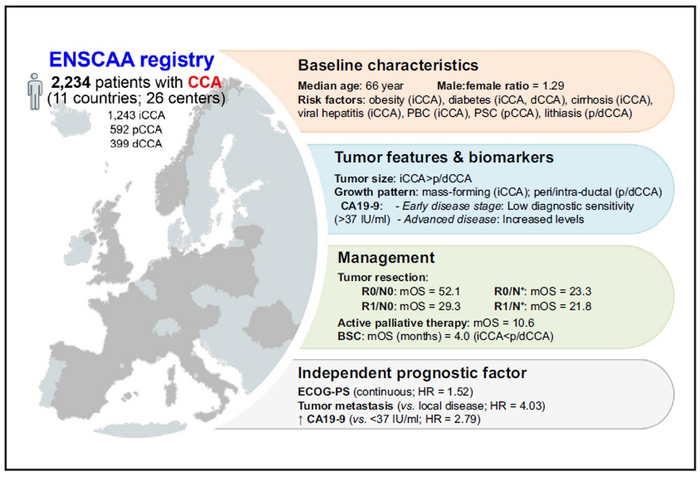Amsterdam, February 12, 2022 – Bile duct cancer, also known as cholangiocarcinoma (CCA), is a rare cancer often diagnosed only at an advanced stage. A comprehensive analysis of diagnostic, prognostic, and therapeutic aspects of over 2,200 patients in Europe now provides a valuable knowledge base for raising awareness and managing CCA to improve outcomes. This study is reported in the Journal of Hepatology, the official journal of the European Association for the Study of the Liver, published by Elsevier.

Credit: Journal of Hepatology
Amsterdam, February 12, 2022 – Bile duct cancer, also known as cholangiocarcinoma (CCA), is a rare cancer often diagnosed only at an advanced stage. A comprehensive analysis of diagnostic, prognostic, and therapeutic aspects of over 2,200 patients in Europe now provides a valuable knowledge base for raising awareness and managing CCA to improve outcomes. This study is reported in the Journal of Hepatology, the official journal of the European Association for the Study of the Liver, published by Elsevier.
In 2015, the European Network for the Study of Cholangiocarcinoma (ENSCCA) was founded with the aim of setting up a pan-European-wide interdisciplinary cooperative network to address the CCA problem at basic, translational, and clinical levels. Its first initiative was the creation of the Clinical ENSCCA Registry in 2016 to describe in detail the natural course of CCA in Europe, determine potential risk factors, improve the current classification system, investigate early and non-invasive accurate tumor biomarkers for diagnosis and to estimate prognosis, compare the effectiveness of therapies, and select patients for clinical trials.
“CCA is a rare cancer, but its incidence is increasing worldwide, and we need to stop treating it as an orphan disease,” explained lead investigator Dr. Jesus M. Banales, Professor Ikerbasque at Biodonostia, University of Navarra and CIBERehd, Spain. “Although CCA constitutes a major challenge for clinicians, scientists, national health systems, and society, there is a lack of coordinated multidisciplinary pan-European studies. We therefore used the ENSCCA registry to gather vital information.”
In the most comprehensive international observational study to date, investigators evaluated the natural course of histologically proven CCA in more than 2,200 patients who were diagnosed between 2010-2019 and whose details were included in the ENSCCA registry. The data were contributed by 26 referral hospitals in 11 European countries. At diagnosis, 42.2% of patients had local disease, 29.4% had locally advanced disease, and 28.4% had metastatic disease. They compared general and tumor-type specific features at diagnosis, risk factors, biomarker accuracy, as well as the similarities and differences between the three CCA subtypes based on the latest World Health Organization classification according to their anatomical origin (intrahepatic, perihilar, or distal), and a comparison of patient management and outcomes.
The results suggest that the location of CCA tumors along the biliary tree is associated with different risk factors and tumor features. Diagnoses need invasive confirmations by biopsy or cytology, as blood tests for tumor biomarkers show low sensitivity in early stages. Surgical resection remains the only potentially curative therapy, although cure is unlikely with involvement of resection margins or lymph node invasion. Investigators noted that chemotherapy increased patients’ life expectancy compared to patients receiving best supportive care. They also noted that deterioration of the patient’s performance status (ECOG), the presence of metastases, and increased levels of the tumor marker CA19-9 independently affected the outcome.
A comparative analysis of risk factors of the three different locations of CCA tumors revealed some potential lifestyle-related risk factors such as alcohol excess, smoking, overweight/obesity, diabetes, etc. These are highly prevalent in Europe and could predispose at-risk individuals to the development of CCA.
“In conclusion, our study provides a comprehensive analysis of diagnostic, prognostic, and therapeutic aspects of the complex CCA landscape,” commented Dr. Banales. “The results showed that CCA is mostly diagnosed at an advanced stage, a significant proportion of patients fail to receive any cancer-specific therapy, and the prognosis is dismal. Therapeutic options are limited. Accordingly, awareness campaigns and education programs aimed to prevent lifestyle-related risk factors and new techniques for early detection of CCA in high-risk populations are urgently needed in order to decrease cancer-related mortality. Our findings represent valuable knowledge for future comparisons with new targeted therapies and the design of next-generation personalized clinical trials.”
CCA is a highly heterogenous and aggressive malignancy responsible for around 2% of all cancer-related deaths globally each year. It is often diagnosed when it is already advanced, making it difficult to treat successfully. Currently it represents approximately 15% of all primary liver cancers and 3% of all gastrointestinal cancers worldwide.
World Cholangiocarcinoma Day, February 12, 2022, was established by the Global Cholangiocarcinoma Alliance (GCA), which has united to establish a global voice about CCA through community collaborations. The GCA has a shared vision to raise awareness of CCA to improve prevention, survival, and quality of life of CCA patients globally. https://globalccaalliance.com/en/world-cca-day
Journal
Journal of Hepatology
DOI
10.1016/j.jhep.2021.12.010
Method of Research
Observational study
Subject of Research
People
Article Title
Cholangiocarcinoma landscape in Europe: Diagnostic, prognostic and therapeutic insights from the ENSCCA Registry
Article Publication Date
12-Feb-2022




